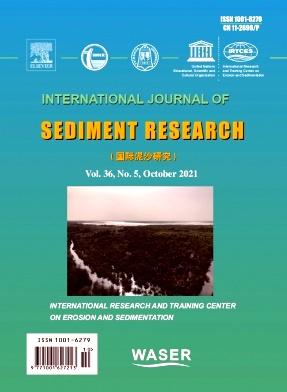Insights into the impacts of inflow discharge variation on cross-sectional topography in the upper neck area of a laboratory-scale subaerial delta from SWJ–LSTM simulations
IF 3.7
2区 环境科学与生态学
Q2 ENVIRONMENTAL SCIENCES
引用次数: 0
Abstract
Rivers significantly influence delta morphology and sedimentation patterns. However, the dynamic effects of rivers on the upper neck areas of subaerial deltas, which are the complex zones connecting main channels to distributary networks, remain understudied. In this research, the impacts of discharge variation on cross-sectional topography within the upper neck area of a laboratory-scale subaerial delta were examined via an integrated shallow water jet (SWJ)–long short-term memory (LSTM) modeling approach that synergistically couples SWJ equations incorporating analytical velocity distributions and parameterized bedload transport relationships with LSTM networks and gradient boosting for data-driven enhancements. Laboratory experiments, which provide detailed topographic measurements, were used for model calibration and validation. We investigated stepwise, periodic, and stochastic discharge alteration scenarios. The results revealed a fundamental pattern of spatially differentiated morphodynamic sensitivity within the upper neck area. The section farthest upstream consistently exhibited relative stability. In stark contrast, the mid-sections (spanning approximately 20%–30% of the total delta length from the inlet) emerged as the primary loci of morphological change, consistently demonstrating robust switching behaviors between pronounced erosion and deposition regimes under varying discharge regimes. In contrast, the section farthest downstream showed a more integrated and dampened response. This distinct switching mechanism within defined mid-sections, rather than diffuse variability, constituted a key finding regarding the mechanism by which the upper neck area could fundamentally process discharge fluctuations. Specifically, discharge decreases typically led to localized scouring and enhanced channelization, particularly within these active mid-sections. Conversely, increases in discharge induced increasingly complex responses involving erosion and deposition, with the specific outcome being dependent on the precise location within these mid-sections and on the nature of discharge alteration. The core components of the morphological evolution of the delta were further evaluated by the finding that the magnitude, rate, and timing of discharge changes (e.g., rapid exponential changes and slow logistic decreases), along with the amplitude of periodic fluctuations, significantly governed the intensity and characteristics of this switching behavior and the resultant morphology. Increasingly pronounced effects were observed under rapid exponential changes, slow logistic decreases, and large periodic amplitudes. Under stochastic discharge, the mean reversion rate and long-term mean volatility of discharge exerted complex, spatially variable influences on the mean bed elevation change, highlighting their critical roles in shaping morphology, whereas the volatility had a more subtle and discharge-dependent impact. Thus, this research revealed not only variability but also a spatially organized response framework featuring critical zones and specific mechanisms, such as mid-section switching, governed by identifiable hydraulic parameters. The findings offered practical insights into delta management, climate adaptation, and environmental assessment, strengthening our understanding of fluvial–deltaic interactions and supporting ecosystem sustainability.
来自SWJ-LSTM模拟的入流流量变化对实验室尺度陆上三角洲上颈区域横截面地形的影响
河流对三角洲形态和沉积模式有显著影响。然而,河流对陆上三角洲上颈区(连接主河道和分流网络的复杂地带)的动态影响仍未得到充分研究。本研究通过集成浅水射流(SWJ)长短期记忆(LSTM)建模方法,研究了流量变化对实验室规模陆上三角洲上颈部区域横截面地形的影响,该方法将包含解析速度分布和参数化层载输运关系的SWJ方程与LSTM网络和梯度增强协同耦合,以实现数据驱动的增强。提供详细地形测量的实验室实验用于模型校准和验证。我们研究了逐步、周期性和随机放电变化情景。结果揭示了上颈部区域形态动力学敏感性空间分化的基本模式。最上游的部分始终表现出相对稳定。与此形成鲜明对比的是,中部(从入口开始约占三角洲总长度的20%-30%)是形态变化的主要位点,在不同的流量下,始终表现出明显的侵蚀和沉积模式之间的强大切换行为。相比之下,最下游的部分表现出更完整和更阻尼的响应。这种在确定的中间区域内的独特开关机制,而不是漫射变异性,构成了关于上颈部区域可以从根本上处理放电波动的机制的关键发现。具体来说,流量的减少通常会导致局部冲刷和河道化的增强,特别是在这些活跃的中段。相反,流量的增加引起了越来越复杂的反应,包括侵蚀和沉积,具体结果取决于这些中段的精确位置和流量变化的性质。通过发现放电变化的幅度、速率和时间(例如,快速的指数变化和缓慢的逻辑下降)以及周期性波动的幅度,进一步评估了三角洲形态演变的核心组成部分,这些变化显著地控制了这种开关行为的强度和特征以及由此产生的形态。在快速的指数变化、缓慢的logistic衰减和较大的周期振幅下,观察到越来越明显的效应。随机流量条件下,平均回复率和长期平均波动率对平均河床高程变化的影响具有复杂的空间变异性,突出了其在形态塑造中的关键作用,而波动率的影响则更为微妙,且与流量有关。因此,本研究不仅揭示了可变性,而且揭示了一个空间组织的响应框架,其特征是由可识别的水力参数控制的关键区域和特定机制,如中段切换。这些发现为三角洲管理、气候适应和环境评估提供了实用的见解,加强了我们对河流-三角洲相互作用的理解,并支持了生态系统的可持续性。
本文章由计算机程序翻译,如有差异,请以英文原文为准。
求助全文
约1分钟内获得全文
求助全文
来源期刊
CiteScore
6.90
自引率
5.60%
发文量
88
审稿时长
74 days
期刊介绍:
International Journal of Sediment Research, the Official Journal of The International Research and Training Center on Erosion and Sedimentation and The World Association for Sedimentation and Erosion Research, publishes scientific and technical papers on all aspects of erosion and sedimentation interpreted in its widest sense.
The subject matter is to include not only the mechanics of sediment transport and fluvial processes, but also what is related to geography, geomorphology, soil erosion, watershed management, sedimentology, environmental and ecological impacts of sedimentation, social and economical effects of sedimentation and its assessment, etc. Special attention is paid to engineering problems related to sedimentation and erosion.

 求助内容:
求助内容: 应助结果提醒方式:
应助结果提醒方式:


